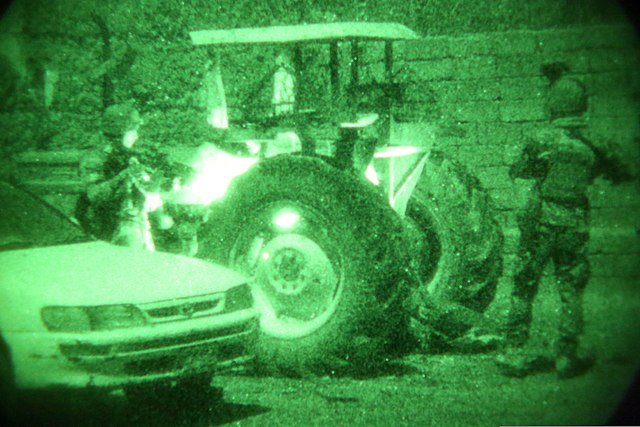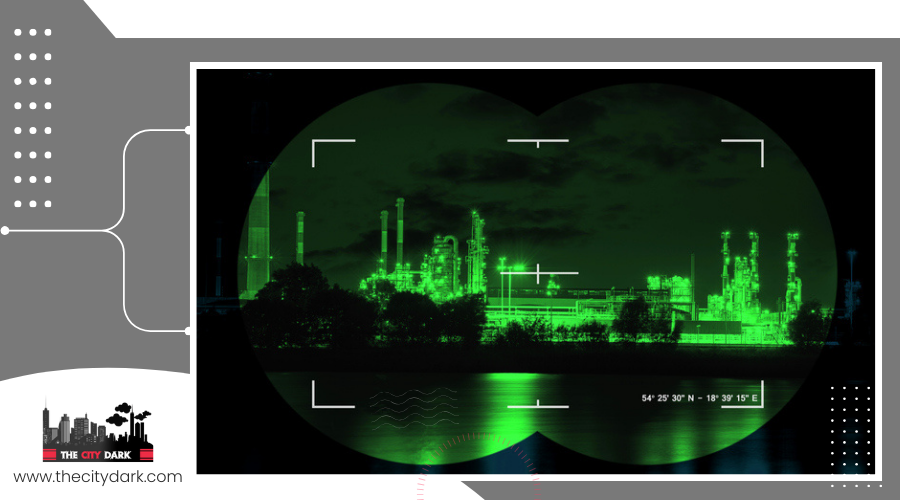Night vision struggles without ample light, limiting visibility. It often produces images in monochrome, diminishing detail, and performs poorly in fog, rain, or smoke. Its operational range is constrained, and bright lights can spoil image quality. The cost of top-tier devices might deter many. At night, your vision isn’t as acute, affecting depth perception and creating halos around lights. Light pollution and weather conditions further challenge its effectiveness. Delving deeper reveals the impact of these issues and potential solutions.
Key Takeaways
- Night vision needs light; it cannot see in total darkness.
- It shows images in black and white, losing color detail.
- Fog, rain, and city lights lessen its power.
- Battery life and the need for much power limit use.
- People’s eyes and things in the way also limit how well it works.
Ambient Light Dependency
Night vision’s flaw is its need for ambient light. Low light means poor visibility. This affects range and clarity. Eye strain from trying to see in the dark can be harmful. Thermal imaging offers some relief, but doesn’t solve everything.
Technological Constraints

Beyond the challenge tied to ambient light, night vision tech faces inherent limitations that affect its performance. Night vision aids in seeing under low-light but comes with drawbacks.
Here’s a streamlined overview of these constraints:
| Constraint | Explanation | Effect on Night Vision |
|---|---|---|
| Color Perception | Uses monochrome images, lessening color precision. | Reduces visual detail |
| Environmental Impact | Fog, rain, smoke scatter light, weakening efficiency. | Decreases clarity |
| Range | Has trouble spotting objects beyond a certain distance. | Narrows operational scope |
| Artificial Light Glare | Leads to blooming, lowering visibility and clarity. | Impairs image quality |
| Cost | High-end devices are costly, limiting accessibility. | Restricts availability |
These limitations show that while night vision technology boosts your night sight, it’s not flawless. The light that enters the eye through these devices can be influenced by various factors, from environmental conditions like fog and rain to the glare from artificial lights. Another significant limitation is the distance these devices can effectively work, alongside the substantial cost required for top-quality equipment.
Human Vision Limitations
Despite advancements in night vision technology, human eyes struggle in dim light. You may have noticed that your night vision isn’t as good as during the day. This is because our eyes can’t see well in low light. It’s hard to see clearly at night, leading to blurred vision and trouble seeing colors. This affects your depth perception and ability to move in the dark.
Also, artificial light at night can cause halos around lights or make your vision cloudy. This is due to glare affecting your night vision. Age, health conditions, and daily health can also impact your night vision. Our eyes can’t provide clear images or sharp focus in the dark like they can in daylight, making technology necessary for better night vision.
Environmental Impact

In dark settings, human eyes falter, prompting us to consider how environmental elements affect night vision technology. Night vision devices, which boost available light to produce images in darkness, face hurdles from their environments.
| Challenge | Impact on Night Vision |
|---|---|
| Light Pollution | Dims effectiveness with city light glare. |
| Weather Conditions | Shrinks range and clarity in fog, rain, or snow. |
| Natural Obstacles | Blocks view with trees, bushes, or uneven land. |
Urban light pollution can greatly reduce night vision gear’s effectiveness, creating a glare that overwhelms the device’s sensors. Weather, including fog, rain, or snow, can also severely restrict what you see, complicating navigation or object identification from afar.
Additionally, natural barriers like trees, bushes, or uneven ground can hide your view. Surfaces reflecting light, like water or glass, can produce glare, distorting the images your night vision system captures. These environmental impacts challenge reliance on night vision technology in various situations.
Power and Durability Concerns
Many night vision devices often need new batteries or charging because their batteries don’t last long. This problem is big when you’re using them for a long time. You don’t want your night vision to stop working because of battery problems. The high power use of these devices makes this problem worse, making it hard to keep them working when you really need them.
Also, night vision gear can break easily, especially in tough weather. This issue can make them not last as long, so it’s important to think about how long your night vision gear will work.
To solve these problems, new battery technology is being made to make night vision systems work better and last longer. This improvement should help your night vision tools stay useful for a longer time, even with a lot of use.
- Changing batteries or charging often can stop important work.
- Bad weather can make them break faster, which means they won’t last as long.
- New battery technology is being made to help with these problems, making night vision devices last longer and more reliable.
Frequently Asked Questions
What Are the Limitations of Night Vision Technology?
Night vision technology struggles with several issues. It uses a lot of power. The images it produces are not always clear. Bad weather can affect it. It only lets you see a small area at once and makes it hard to judge distance. Plus, it’s expensive. These problems can make it less useful and harder to get.
What Is Night Vision Problems?
You face color distortion, limited battery life, high costs, and environmental limits. Light sensitivity and low resolution impair night vision. These issues hinder clear sight in the dark.
What Is Night Vision Difficulty?
You struggle to see at night. Colors blend together. Distance becomes hard to judge. Batteries drain fast. Rain or fog blurs everything. Spotting movement is tough. Darkness fills with grainy shadows. Fix these to see better after sunset.
What Are the Factors Affecting Night Vision?
The quality of your night vision hinges on several key elements: the surrounding light, the response of animal eyes, the state of the weather, the caliber of the lens, energy use, and how well you perceive depth. Each influences your ability to see when it’s dark.
Conclusion
In conclusion, night vision struggles with a few key issues. It needs some light to work, and technology today limits it. It also can’t see as well as we can. Plus, it might harm the environment, uses a lot of power, and isn’t always reliable. But, it’s still useful. We should know its flaws and try to fix them, making it better and more eco-friendly.

